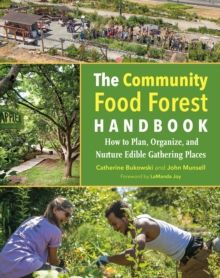Description
| Product ID: | 9781603586443 |
| Product Form: | Paperback / softback |
| Country of Manufacture: | CA |
| Title: | The Community Food Forest Handbook |
| Subtitle: | How to Plan, Organize, and Nurture Edible Gathering Places |
| Authors: | Author: Catherine Bukowski, John Munsell |
| Page Count: | 272 |
| Subjects: | City and town planning: architectural aspects, City & town planning - architectural aspects, Cultural studies: food and society, Central / national / federal government policies, Urban and municipal planning and policy, Agriculture and farming, Sustainable agriculture, Forestry and silviculture, Gardening: plants and cultivation guides, Specialised gardening methods, Food & society, Central government policies, Urban & municipal planning, Agriculture & farming, Sustainable agriculture, Forestry & silviculture: practice & techniques, Gardening: plants, Specialized gardening methods |
| Description: | Select Guide Rating Guidance, information and inspiration for individuals and groups working toward the establishment of food forests and edible gathering spaces. Collaboration and leadership strategies for long-term success Fueled by the popularity of permaculture and agroecology, community food forests are capturing the imaginations of people in neighborhoods, towns, and cities across the United States. Along with community gardens and farmers markets, community food forests are an avenue toward creating access to nutritious food and promoting environmental sustainability where we live. Interest in installing them in public spaces is on the rise. People are the most vital component of community food forests, but while we know more than ever about how to design food forests, the ways in which to best organize and lead groups of people involved with these projects has received relatively little attention. In The Community Food Forest Handbook, Catherine Bukowski and John Munsell dive into the civic aspects of community food forests, drawing on observations, group meetings, and interviews at over 20 projects across the country and their own experience creating and managing a food forest. They combine the stories and strategies gathered during their research with concepts of community development and project management to outline steps for creating lasting public food forests that positively impact communities. Rather than rehash food forest design, which classic books such as Forest Gardening and Edible Forest Gardens address in great detail, The Community Food Forest Handbook uses systems thinking and draws on social change theory to focus on how to work with diverse groups of people when conceiving of, designing, and implementing a community food forest. To find practical ground, the authors use management phases to highlight the ebb and flow of community capitals from a project’s inception to its completion. They also explore examples of positive feedbacks that are often unexpected but offer avenues for enhancing the success of a community food forest. The Community Food Forest Handbook provides readers with helpful ideas for building and sustaining momentum, working with diverse public and private stakeholders, integrating assorted civic interests and visions within one project, creating safe and attractive sites, navigating community policies, positively affecting public perception, and managing site evolution and adaptation. Its concepts and examples showcase the complexities of community food forests, highlighting the human resilience of those who learn and experience what is possible when they collaborate on a shared vision for their community. |
| Imprint Name: | Chelsea Green Publishing Co |
| Publisher Name: | Chelsea Green Publishing Co |
| Country of Publication: | GB |
| Publishing Date: | 2018-07-24 |


